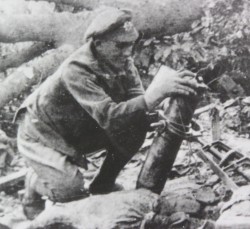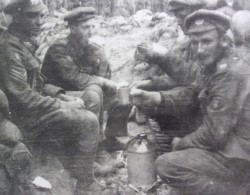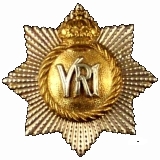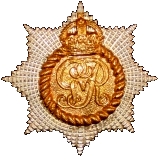
The Royal Canadian Regiment and
The First World War - 1914-1919
The 7th Trench Mortar Battery
"Somewhere in France"
By: Captain Michael M. O'Leary, orginally published in the regimental journal of The Royal Canadian Regiment, PRO PATRIA 2007
In the February 1932 edition of The Connecting File are two photographs that are familiar to many Royal Canadians. Printed under the headline "Somewhere in France", and republished periodically since that time, these are two of the few images showing soldiers of the Regiment in the fieldduring the First World War. We know for certain that these soldiers belong to the Regiment because they are rare examples in which their cap badges can be clearly identified.

Cpl Edwin McGowran, The RCR, mans a 4" mortar of the 7th Trench Mortar Battery.

Soldiers of The RCR and one man from the 49th Battalion serving with the 7th Trench Mortar Battery.
But one aspect of these photos has not accompanied them during their progress through successive reprinting by the Regiment. The subsequent issue of The Connecting File, the April 1932 edition,put names to these soldiers.
About the first photo, of four soldiers brewing tea in a sandbagged trench, F.E. McGowran, ex-Corpl. The RCR, wrote:
"The chap with the sorry looking mug on the left is none other than myself. Why should I look so blasted miserable I find it hard to contemplate as I was awaiting until the P.M. of the very day upon which the snap was taken, and with a pass to 'Blighty' then actually in my possession, before proceeding to Poperinghe, there to entrain for Boulogne. I distinctly recollect placing a piece of bread on a sand-bag before the snap was taken (you will note it is still there).
"That good looking swaddie on my left is Copeland [sic]. I believe, of 'C' Company. Morris is the chap opposite me. He was servant to the late Lieut. Towers. Both Morris and Mr. Towers were killed in action. As you were, I am wrong about Morris; I think it was a chap named Crossman who was servant to Mr. Towers. Morris, I believe, was slightly wounded. I hope he is being permitted to 'fade away.'
"Number four in the group is a darn good soldier of the 49th Battalion. I do not recollect his name.
"The group of four represents a section of the then termed 7th Canadian Trench Mortar Battery. This Battery was the first to handle the Stokes Gun in the Canadian lines, I was told."
Of the second photo, showing a soldier preparing to fire a small trench mortar, McGowran adds:
"Picture number two is also of myself, and it was taken unbeknown to me as I was actually serving a 4-inch R.M.L preparatory to firing on the German lines from "K" trenches, Ypres salient.
"This particular trench mortar was a somewhat ticklish one to handle. The gun I am seen with in the picture was ordered evacuated from the lines the night of the day upon which the snap was taken. Quite naturally we desired to expend whatever ammunition was left. You see me sighting the gun for that purpose."
7th Light Trench Mortar Battery
Many of the soldiers of the Light Trench Mortar Batteries were infantry troops from each Brigade's battalions. The 7th Canadian Light Trench Mortar Battery, therefore, included soldiers of The RCR, the P.P.C.L.I. and the 42nd and 49th Canadian Infantry Battalions.
Matching Cpl McGowan's comment about the move of his mortar from the lines, the War Diary for the 7th Light Trench Mortar Battery has the following entry for 26 May 1916:
"19 rounds fired on Enemy's Front Lines & Support Trenches at J.13.c.9.10. 4" R.M.L. removed from trenches on order from Bde B.O."
The Soldiers
477638 Corporal Edwin McGowran joined The RCR at Halifax in March 1912. He served in the Regiment at Halifax, in Bermuda and during the Great War in France. From the address and photo provided with his letter to the Connecting File, he appears to have been a police officer in Kentville, Nova Scotia, after the war. Before joining The RCR, McGowan had previously served in The Royal Fusiliers for 4 years.
477198 Pte Ernest Coupland joined the Regiment in July 1910. During the Great War he served with the Regiment in Bermuda and in France. He would also survive the war.
Identifying Morris is a little more problematic. There were at least five men named Morris in the Regiment, with regimental numbers 477601, 477602, 477603, 477604 and 477605. No. 477602 was actually named Bryson, but served under the name Morris. These consecutive regimental numbers were the result of the entire battalion being reattested for overseas service with the CEF at Halifax after serving in Bermuda. Unfortunately, we may never know for sure which Morris is in the photo with McGowan.
Pro Patria
- The O'Leary Collection; Medals of The Royal Canadian Regiment.
- Researching Canadian Soldiers of the First World War
- Researching The Royal Canadian Regiment
- The RCR in the First World War
- Badges of The RCR
- The Senior Subaltern
- The Minute Book (blog)
- Rogue Papers
- Tactical Primers
- The Regimental Library
- Battle Honours
- Perpetuation of the CEF
- A Miscellany
- Quotes
- The Frontenac Times
- Site Map

![]() The RCR in the Great War
The RCR in the Great War
![]() War Diary
War Diary
![]() Battle Honours
Battle Honours
![]() Battle Bars and The RCR
Battle Bars and The RCR
![]() The RCR Battle Bar Ledger (pdf)
The RCR Battle Bar Ledger (pdf)
![]() Honours and Awards
Honours and Awards
![]() Roll of Honour
Roll of Honour
![]() Prisoners of War
Prisoners of War
![]() Cemetery List
Cemetery List
![]() Cemetery Map
Cemetery Map
![]() Courts Martial
Courts Martial
![]() Officers
Officers
![]() RSMs of The RCR (1914-1919)
RSMs of The RCR (1914-1919)
![]() NCOs and Soldiers
NCOs and Soldiers
![]() An Officer's Diary (1914-1918)
An Officer's Diary (1914-1918)
![]() Recollections of a Nonagenerian (R. England) (1916-1919)
Recollections of a Nonagenerian (R. England) (1916-1919)
![]() On to Bermuda (1914-15)
On to Bermuda (1914-15)
![]() England and France 1915-1916 (Hayes; 1931)
England and France 1915-1916 (Hayes; 1931)
![]() Overseas with The Royals (1915)
Overseas with The Royals (1915)
![]() Regimental History Pamphlet (1917)
Regimental History Pamphlet (1917)
![]() Amiens (1918)
Amiens (1918)
![]() Cambrai (1918)
Cambrai (1918)
![]() Monchy-le-Preux (1918)
Monchy-le-Preux (1918)
![]() Under-aged Soldiers in The RCR
Under-aged Soldiers in The RCR
![]() Not All Were Volunteers; The RCR and the Military Service Act
Not All Were Volunteers; The RCR and the Military Service Act
![]() Sentenced to Death by Court Martial
Sentenced to Death by Court Martial
![]() The 7th Trench Mortar Battery
The 7th Trench Mortar Battery
![]() A Regimental Goat
A Regimental Goat
![]() Regiment and Family, Bermuda 1914-15
Regiment and Family, Bermuda 1914-15
![]() "March the Guilty Bastard In"
"March the Guilty Bastard In"
![]() Surrendered as Stowaway
Surrendered as Stowaway
![]() Re-Visiting the Great War Roll of Honour for The RCR
Re-Visiting the Great War Roll of Honour for The RCR
![]() Canadian Corps Trench Standing Orders (1916)
Canadian Corps Trench Standing Orders (1916)

